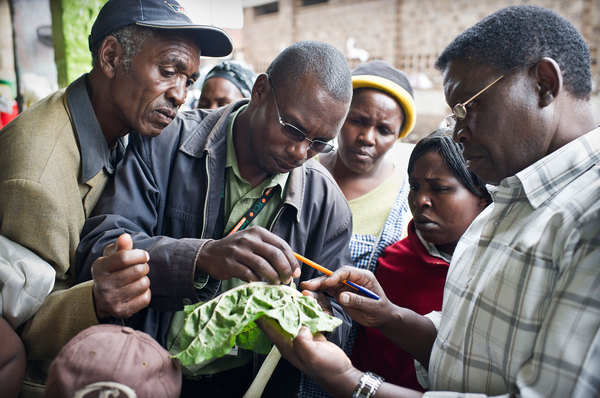Pests and pathogens could cost agriculture billions
The spread of pests and pathogens that damage plant life could cost global agriculture $540 billion a year, according to a report published on Thursday. The report, released by the Royal Botanic Gardens (RBG) at Kew in London, said that an increase in international trade and travel had left flora facing rising threats from invasive…
Kenya gets new production facility to control crop pest
By Sam Otieno. Reblogged from SciDevNet A facility has been launched in Kenya to aid commercial production of a protein bait to control fruit flies in Sub-Saharan Africa. The US$250,000 facility, which resulted from public-private partnership involving the International Centre of Insect Physiology and Ecology (icipe) and Kenya Biologics Ltd, will enable smallholders control fruit flies that devastate their fruits…
Plant Clinics and Farm Visits Diagnosing Fall Armyworm in Malawi
Mr. Guze Kampinga visits the plant clinic at Dowa Turn Off with his damaged maize samples and is received by Mrs Eluby Phiri a trained plant doctor. “I have grown about 0.8 ha of rain-fed and 0.4ha irrigated maize (Ndimba). This year a strange pest has seriously damaged my maize and almost all people in…
Data from plant clinics is contributing to Trinidad and Tobago's agricultural database
Home gardening enthusiasts and farmers from as far as Rio Claro seized the opportunity to have their plant sicknesses diagnosed at a plant clinic hosted by Trinidad and Tobago’s Ministry of Agriculture, Land and Fisheries (MoALF) at its Farmers’ Training Centre in Centeno. After a in-depth one-on-one discussion with Ministry representatives from the Extension, Training and Information Services Division…
CABI working with Partners to Manage Fall Armyworm in Kenya
Kenya has launched a campaign to control the Fall Armyworm, (FAW) which has been sighted by farmers feeding on Maize in Trans Nzoia County, Kenya. Agriculture Cabinet Secretary Mr. Willy Bett said the pest poses a serious threat to the country’s food security situation. “Its impact will be severe given that the country is just…
CPM-12 adopts a record number of new tools for protecting plants from pest spread
This week we’ve been reporting from the 12th session of the Commission on Phytosanitary Measures, which successfully drew to a close, having produced concrete tools to support plant protection through the adoption of 25 International Standards for Phytosanitary Measures (ISPMs). Under the World Trade Organization’s Agreement on the Application of Sanitary and Phytosanitary Measures (SPS…
The benefits and challenges of protecting plants from pest spread – some vivid examples from CPM-12
The 12th session of the Commission on Phytosanitary Measures (CPM) featured a full day of talks covering a range of topics related to plant health. The day began with a session on the benefits (and also the challenges) of implementing the International Plant Protection Convention (IPPC) and the International Standards for Phytosanitary Measures (ISPMs). A…
Plantwise Ghana Educates Farmers on Major Crop Pest and Diseases
As part of its mass extension activities for 2016, Plantwise Ghana rolled out a four-week radio campaign to educate farmers about the detection and management of crop pests and diseases prevalent in the project’s five intervention regions in Ghana. The campaign, which took place between September and October 2016, involved five radio stations noted for…
Five invasive pests cost African economy $1 billion every year
New research by CABI reveals that just five invasive alien species are causing US$0.9 – 1.1 billion in economic losses to smallholder farmers across six eastern African countries each year, equating to 1.8% – 2.2% of total agricultural GDP for the region. These losses are expected to grow to $1.0 – 1.2 billion per year…
South-South collaboration helps in the fight against invasive pests
Invasive species cause widespread devastation and huge economic losses to smallholder farmers across the world, especially in sub-Saharan in Africa. Invasive species not only directly undermine farmer’s ability to achieve food security, they also affect smallholder agribusiness making farmers unable to link to profitable food value chains and international agricultural trade networks.

